Sales Quotas: Using Data to Set, Track & Exceed Goals


Ever had a sales rep tell you their quota feels impossible? Or watched a top performer miss their target because they didn’t have enough pipeline? Quotas should push your team, but they also need to be fair and grounded in reality. Data is the best way to get there.
Without data, you’re setting quotas based on gut feel, past sales performance, or unrealistic top-down targets. This can lead to burnout, missed forecasts, and revenue plans falling apart halfway through the quarter.
It’s a different story when you use conversion rates, sales pipeline trends, and each rep’s quota attainment. Then you’re in a position to create sales quotas that are predictable and fair, but also built to drive growth.
This guide will walk you through how to set, track, and optimize quotas using real numbers.
Use AI and automation to set data-based quotas
With Orum, you can set smarter quotas, track progress in real-time, and help your team outperform its targets.
Setting sales quotas with data: 3 Key principles
If sales quotas aren’t realistic, salespeople disengage, forecasts become unreliable, and leadership struggles to course-correct. A data-driven approach helps you set quotas that feel challenging but are still achievable. That’s how you keep the sales motivation levels high.
1. Use historical performance data to inform targets
“Aim high and hope for the best” isn’t exactly a strategy for setting sales quotas. Instead of setting quotas based on broad company goals, analyze sales data to make smarter decisions. Evaluating past performance is a good place to start. More precisely, you should:
- Look at historical data to see win rates, conversion rates, and average deal sizes over the past few quarters.
- Identify seasonal trends (eg. does pipeline slow down in Q3, do deals close faster in Q4?).
- Compare individual SDR performance to see where adjustments are needed.
- Always analyze data in context (eg. you should know a top performer may sustain a higher quota, while a new hire might need more ramp-up time).
💡Pro tip
Pull sales quota attainment data from the last 12-18 months and map out trends. Then, use these insights from this specific period to set targets that reflect actual performance patterns.
2. Incorporate market trends and external data
Besides internal data, you need to take into account market conditions. If competitors are adjusting their pricing points, buyer behavior is changing, or the economy is slowing down, your quotas need to reflect these factors.
- Track industry benchmarks to see how other companies in your space are setting quotas and establish an accurate baseline for performance.
- Consider economic conditions like inflation, interest rates, and market share changes
- Analyze buyer trends and pay special attention to variations in the length of a sales cycle or budget reallocation.
- If you’re selling a new or niche product, pay attention to adoption rates (in this case, you should expect a longer sales cycle due to the time spent on product education).
💡Pro tip
Layer external data onto your internal trends. If conversion rates are dropping industry-wide, adjust your sales quotas accordingly. Don’t jump to conclusions and assume your sales reps are underperforming.
3. Align quotas with individual and team capacity
Sales targets should stretch your team, but not too thin. You need to aim for a balance between what’s challenging and what’s truly achievable. Don’t set your sales team up for failure.
Also, it might be tempting to assign the same targets across the board to create an even playing field. However, doing so ignores key factors like territory potential, experience level, and product focus. Here’s what you should do instead:
- Adjust quotas based on territory size and quality (eg. it makes sense for a rep in a mature, high-demand region to have higher targets than one breaking into a new market).
- Factor in sales reps’ experience and sales ramp-up time.
- Ensure quotas align with pipeline availability.
- Consider product complexity and sales cycle length (eg. it’s not the same to sell an enterprise solution with a 6-month cycle and a simple, lower-priced product).
💡Pro tip
Segment your sales reps based on experience, region, and pipeline strength. Set quotas that push and motivate them without overwhelming them. This data will also help you create fair compensation plans.
How to track sales quotas in real-time
Setting the right quotas is only half the battle. You also need to track progress, identify risks early, and adjust when needed. The faster you catch trends, the better you can support your salespeople in hitting revenue targets.
Let’s see exactly how to do it with Orum.
Leverage real-time dashboards for transparency
Visibility is everything. If sales managers and reps can’t see quota progress in real-time, they’re operating in the dark. Orum’s real-time dashboards provide instant insights into:
- Rep performance: See who’s ahead, who’s behind, and who needs coaching
- Pipeline health: Track where deals sit in the funnel and spot risks early
- Quota attainment: Compare progress against targets to ensure your sales team paces nicely

💡 Pro tip
Integrating your CRM with Orum makes your sales process smoother and more efficient. Customer data updates automatically, so your team can focus on key revenue goals, spending less time on manual admin tasks and focusing more on actually closing deals.
Use AI to identify bottlenecks and opportunities
Even with the right quotas in place, some deals stall, and some sales reps struggle. The challenge is knowing where to intervene before it’s too late. This is where Orum’s AI-powered insights make a difference to your work and outcomes.
Thanks to AI, you can easily see which deals require more attention and which sales reps could use more support. It’s also simple to spot pipeline bottlenecks and better understand sales objections. The more you know, the easier it is to pinpoint what needs fixing to start hitting your sales goals.
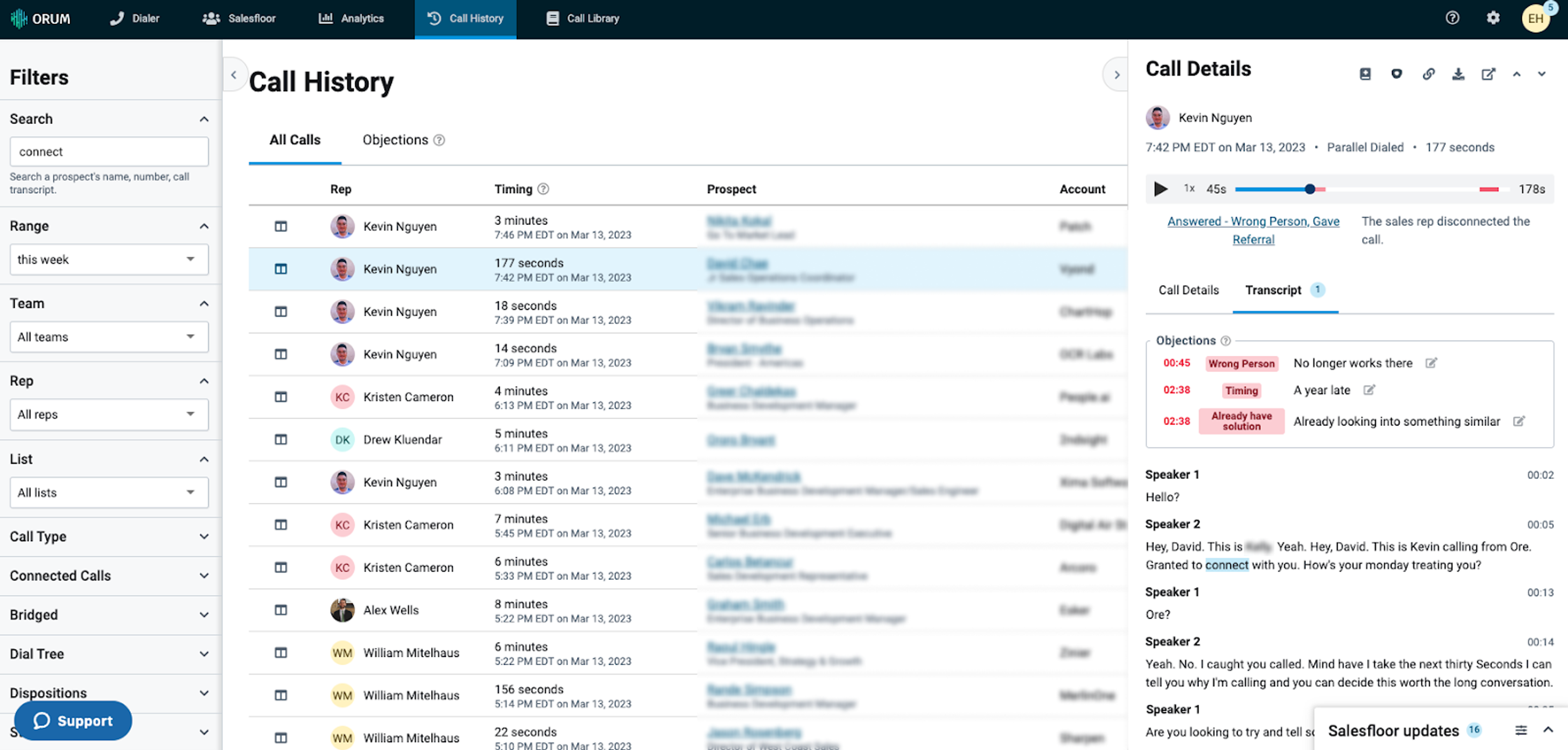
Automate reporting to save time and improve accuracy
Manual sales tracking is a huge time sink. By the time you’ve pulled data, cleaned it up, and built a report, the numbers might already be outdated. Sales leaders don’t have time to sift through spreadsheets. You need accurate, up-to-date insights, fast. That’s where report automation comes in.
With Orum’s automated reporting, you can skip the manual work and get real-time updates on metrics like quota attainment, sales rep performance, and pipeline health. This allows you to spot trends instantly, identify what’s holding your team back, and improve forecast accuracy. No more scrambling to prepare reports for leadership.
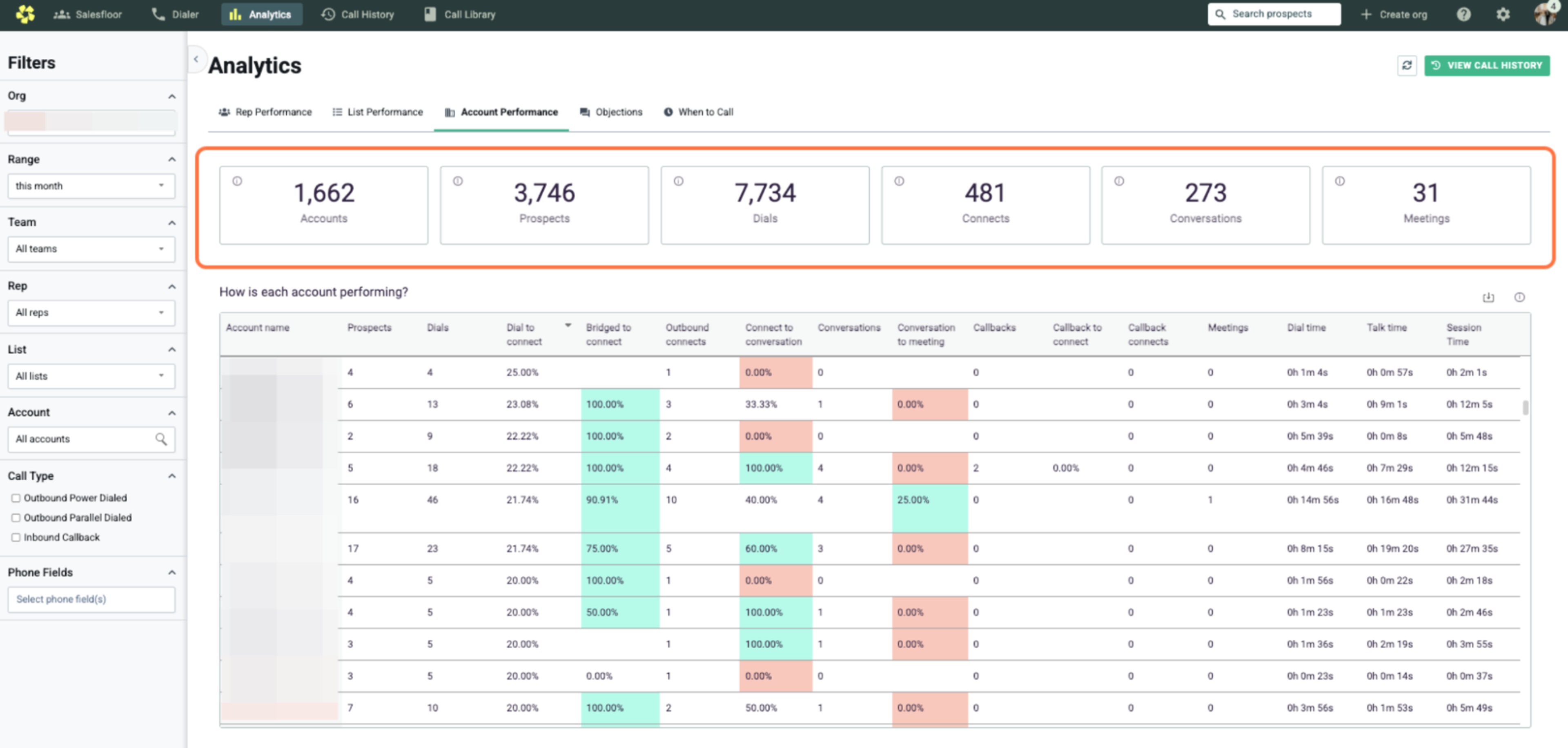
3 Strategies to help sales teams exceed quotas
Want your team to consistently outperform their targets? Then you need smart processes and insights. The best sales teams use data-driven coaching, optimized workflows, and the right tools to stay goals-focused.
1. Provide actionable coaching based on data
Telling reps to “sell more” isn’t coaching or helpful. If anything, it’s micromanaging. If you want your team to improve, you need to coach based on real data, not opinions. You need to review performance trends and tailored SDR training.
Instead of relying on anecdotal feedback, Orum automatically tracks call performance and highlights coaching opportunities so managers can step in where it actually matters. You can also live listen to calls and add coaching notes so that your sales representatives can immediately implement your feedback.
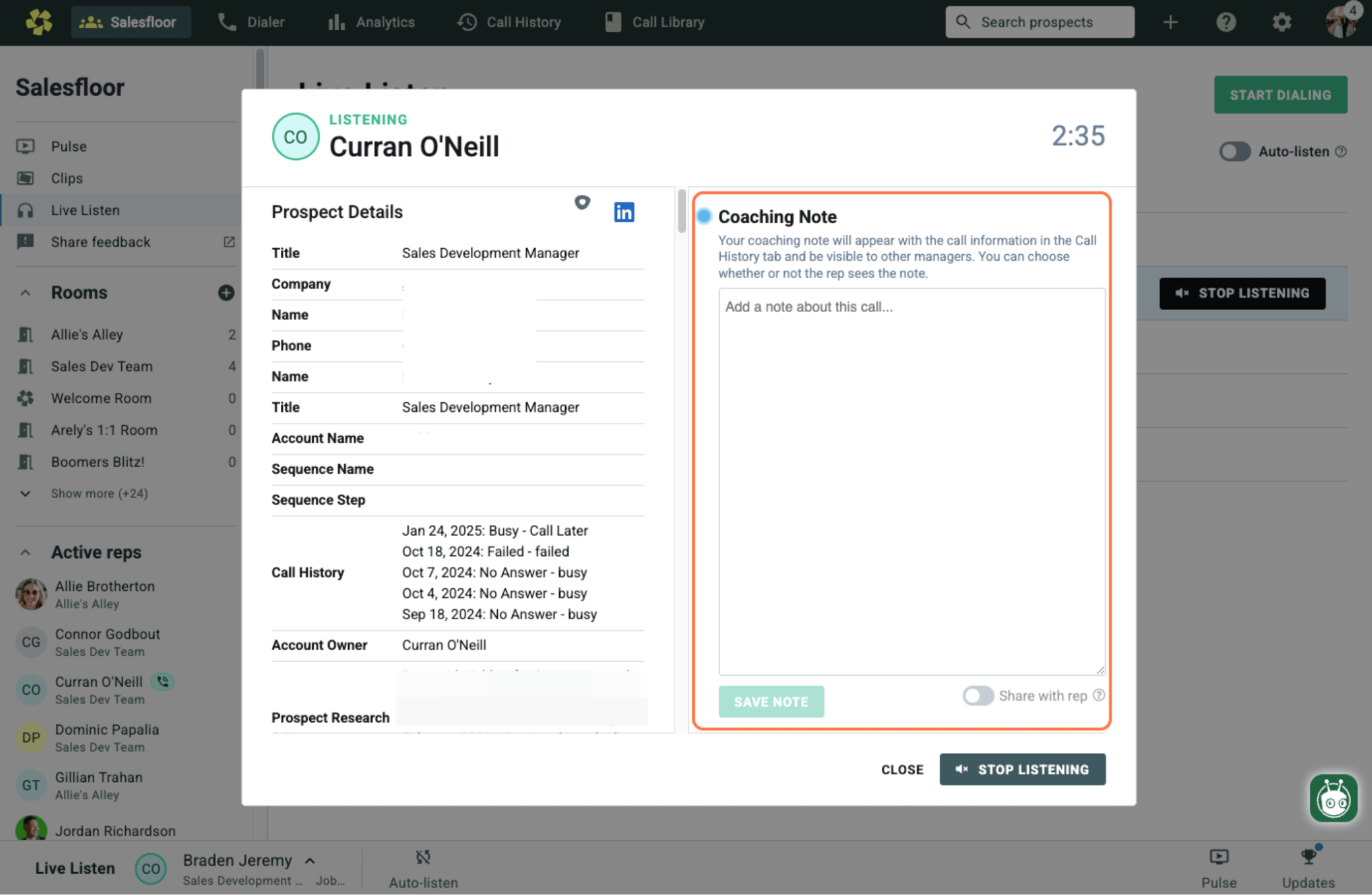
💡 Pro tip
One-size-fits-all training doesn’t work. A sales rep struggling with objection handling needs different support than one struggling with prospecting. Tailored coaching drives sales enablement—so make sure your coaching plans are backed by data.
2. Motivate teams with data-driven incentives
Sales reps want a clear path to success and rewards that are within their reach. The best incentive plans are built around real performance data and what actually motivates your team. Here are a few things you can consider:
- Tie commissions to sales KPIs: Go beyond closed deals and reward reps for sales pipeline generation, call activity, or deal velocity to drive the right behaviors.
- Personalize goals: Not every rep is at the same stage, so use data to set fair but ambitious targets based on experience, territory, and past performance.
- Recognize wins in real-time: Public shoutouts, instant bonuses, or team-wide celebrations keep momentum high and reinforce winning behavior.
Lastly, you know what fuels motivation? Healthy competition. Consider introducing gamification in the form of leaderboards, competitions, and milestone-based rewards.
Orum’s Salesfloor makes it easy to introduce gamification with:
- Real-time leaderboards
- Live call stats
- Team competitions.
Reps can see where they stand, celebrate milestones, and push each other to hit their targets.
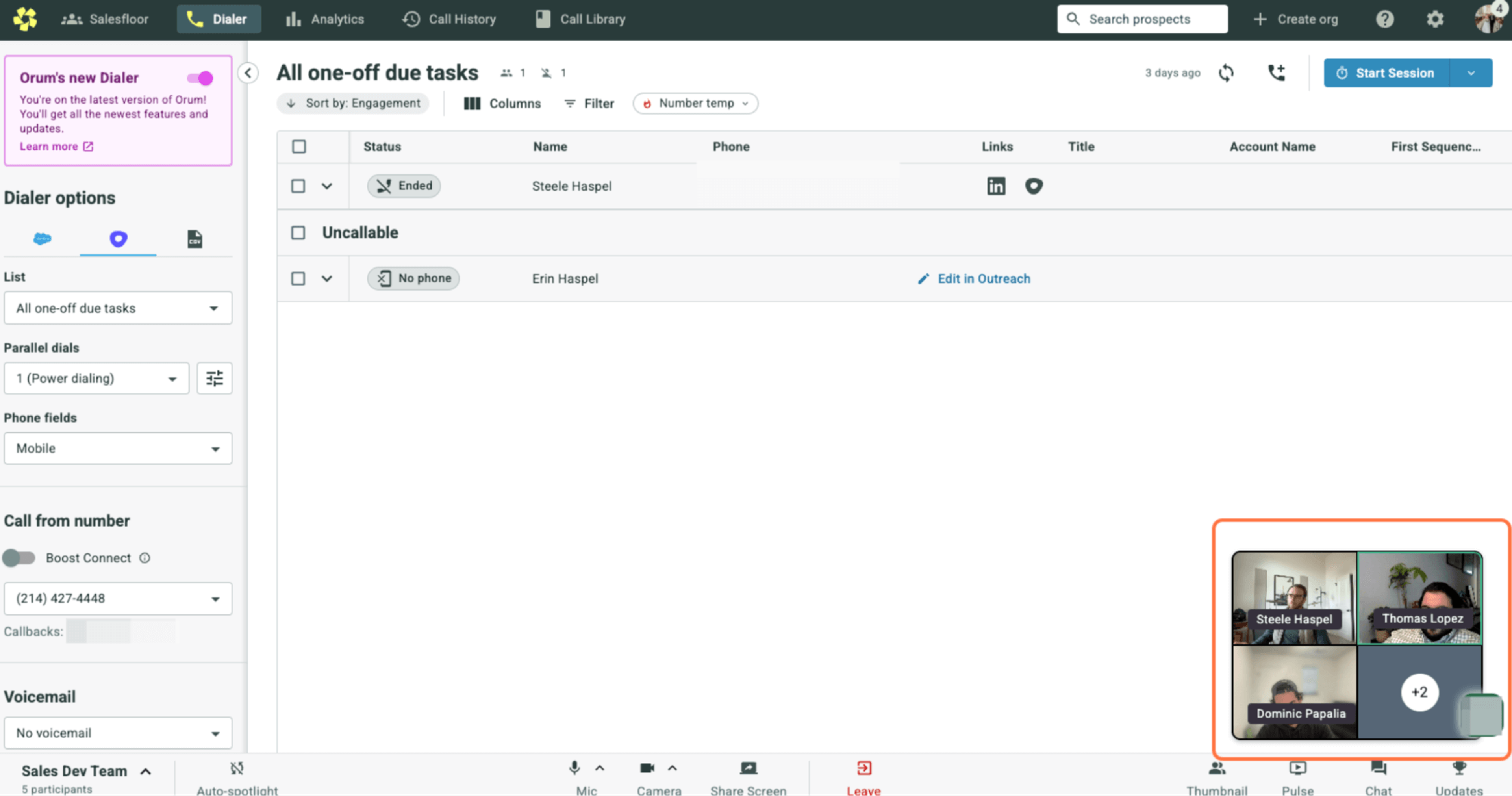
When performance is visible, engagement rises. Reps don’t just meet quotas—they exceed them.
🧠 Did you know?
On average, reps have a 6% higher conversation rate when they dial in the Orum’s Salesfloor.
Use peer learning for strategies and use of tools
Top-performing sales teams learn from each other. Reps pick up winning strategies faster when they can hear real examples, study what works, and refine their approach in real-time. That’s where Orum’s Call Library makes a difference.
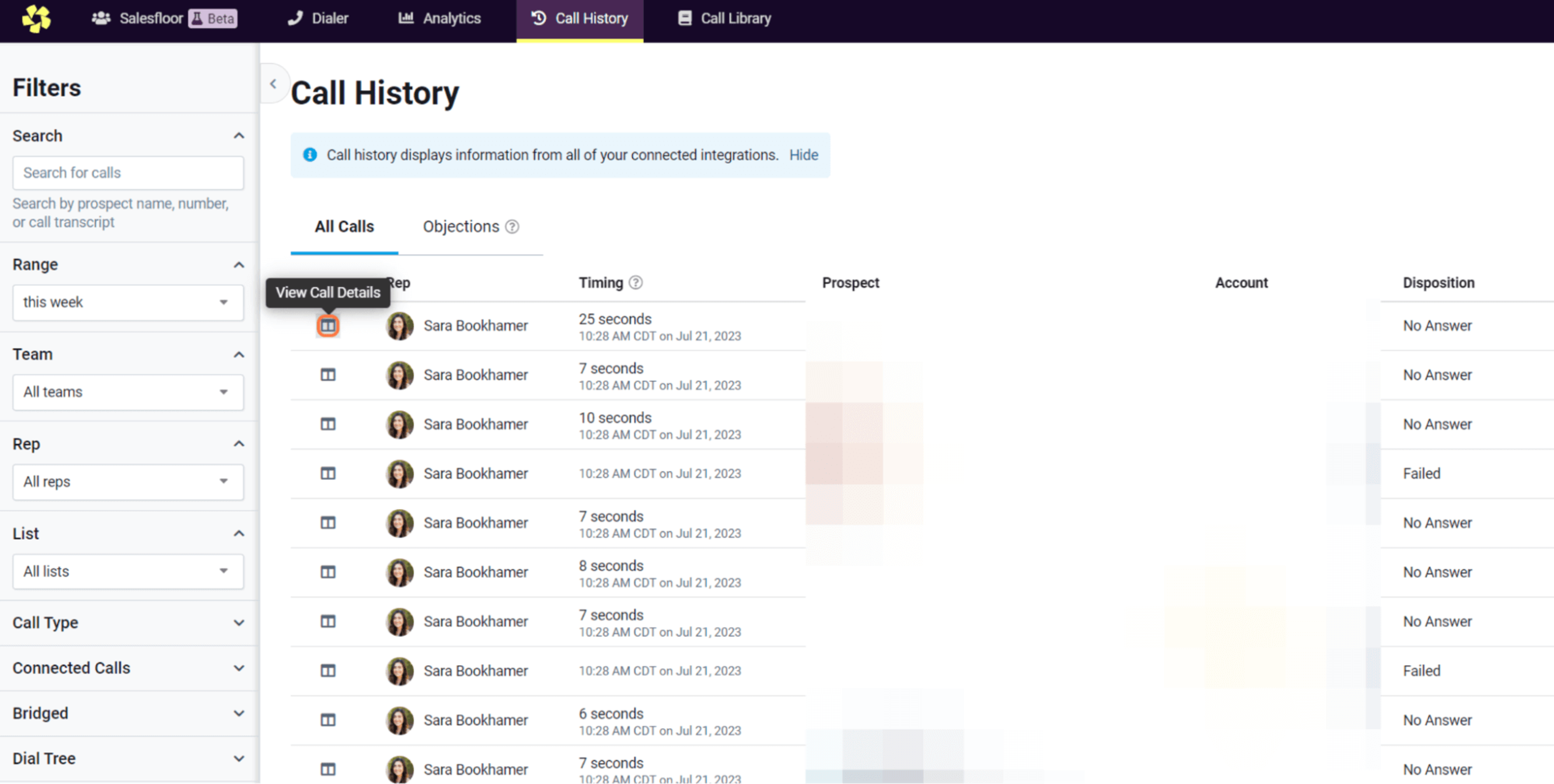
💡 Pro tip
Speed matters for any sales organization. Orum’s Dialer automates outreach and connects reps with live prospects instantly, helping them refine their pitch through higher call volume and better real-time feedback.
Measuring the impact of data-driven sales quotas
Finally, you need to track performance over time to see what’s working and make smarter adjustments over time. Here’s how to do just that.
Track quota attainment over time
The best way to see if your quotas are working is to compare them against past performance. Data-driven quotas should lead to higher attainment rates, more predictable revenue, and a stronger pipeline. Here are the key three best practices you should follow:
- Look at metrics over time: Are more reps consistently hitting quota? Are fewer struggling to keep up? This means your quota-setting strategy is working.
- Compare rep performance before and after: If a sales representative who was missing quotas is now hitting them, that’s a clear sign of improvement.
- Assess sales pipeline efficiency: Are deals moving through the funnel faster? Are conversion rates improving? If yes, then your quotas are driving the right behaviors and outcomes.
Your sales team needs to build a habit of continuously looking at data. Make sure they don’t wait until the end of the quarter to check progress.
Use feedback loops to refine future quotas
Sales quotas should evolve. If reps feel their targets are impossible, motivation tanks. Likewise, if they’re too easy, revenue takes a hit. So, how do you fix this? You need to make sure there’s continuous feedback coming from the people who are actually selling.
That said, different types of sales quotas require different strategies to stay effective. If reps are struggling, the issue might not be the lack of effort. It could be a quota misalignment.
For example, if you see there’s something wrong with the activity quota you’ve set, you need to understand why reps aren’t meeting their call or meeting goals, so check connect rates and conversation quality.
If reps are closing deals but missing the volume quota target, analyze deal flow. Are they spending too much time on large, slow-moving accounts?
In both cases, the first people to turn to are your A-players. So, what do more experienced salespeople have to share?
💡 Pro tip
For profit quota, combination quota, forecast quota, and revenue quota, tracking how current sales activities translate into closed deals is extremely important. If reps are hitting activity goals but missing revenue targets (or vice versa), it’s time to reassess your targets.
Quantify the business impact
Your sales quotas should directly impact revenue, efficiency, and support different business objectives. This is why you need to track key metrics to prove whether your quota strategy is working and where to refine it.
Here’s what you should look at:
- Revenue growth: Are higher quota attainment rates leading to stronger sales numbers? Are reps closing bigger deals or increasing average contract value?
- Sales cycle efficiency: Are deals moving through the funnel faster? Is quota alignment reducing friction in the sales process?
- Ramp-up time: Are new reps hitting quotas faster? Are data-driven targets helping them get productive sooner?
- Customer acquisition cost (CAC): Are smarter quotas making sales efforts more efficient, reducing the cost of bringing in new customers?
Like we said earlier, real-time quota tracking and AI insights make it easy to connect quota performance to these big-picture metrics.
Use data, AI, and automation to set quotas with confidence
Missing targets isn’t always a sales problem—it’s often a quota-setting problem. If revenue is slipping, are reps struggling with conversion, or are they not getting enough at-bats? Do you need to increase deal size, or is pipeline coverage the real issue?
The right move depends on your sales motion and team capacity, but guessing won’t cut it. You need data to pinpoint the problem and adjust quotas accordingly.
With Orum’s AI-driven insights, real-time reporting, and automated processes, you can set smarter quotas and keep your team focused on the right targets.
Use AI and automation to set data-based quotas
With Orum, you can set smarter quotas, track progress in real-time, and help your team outperform its targets.





